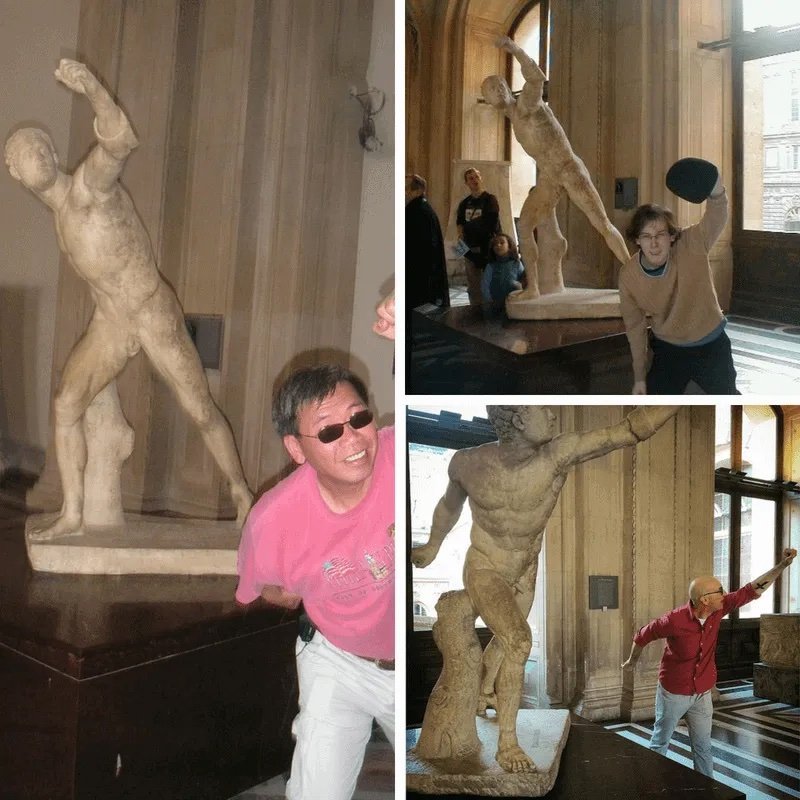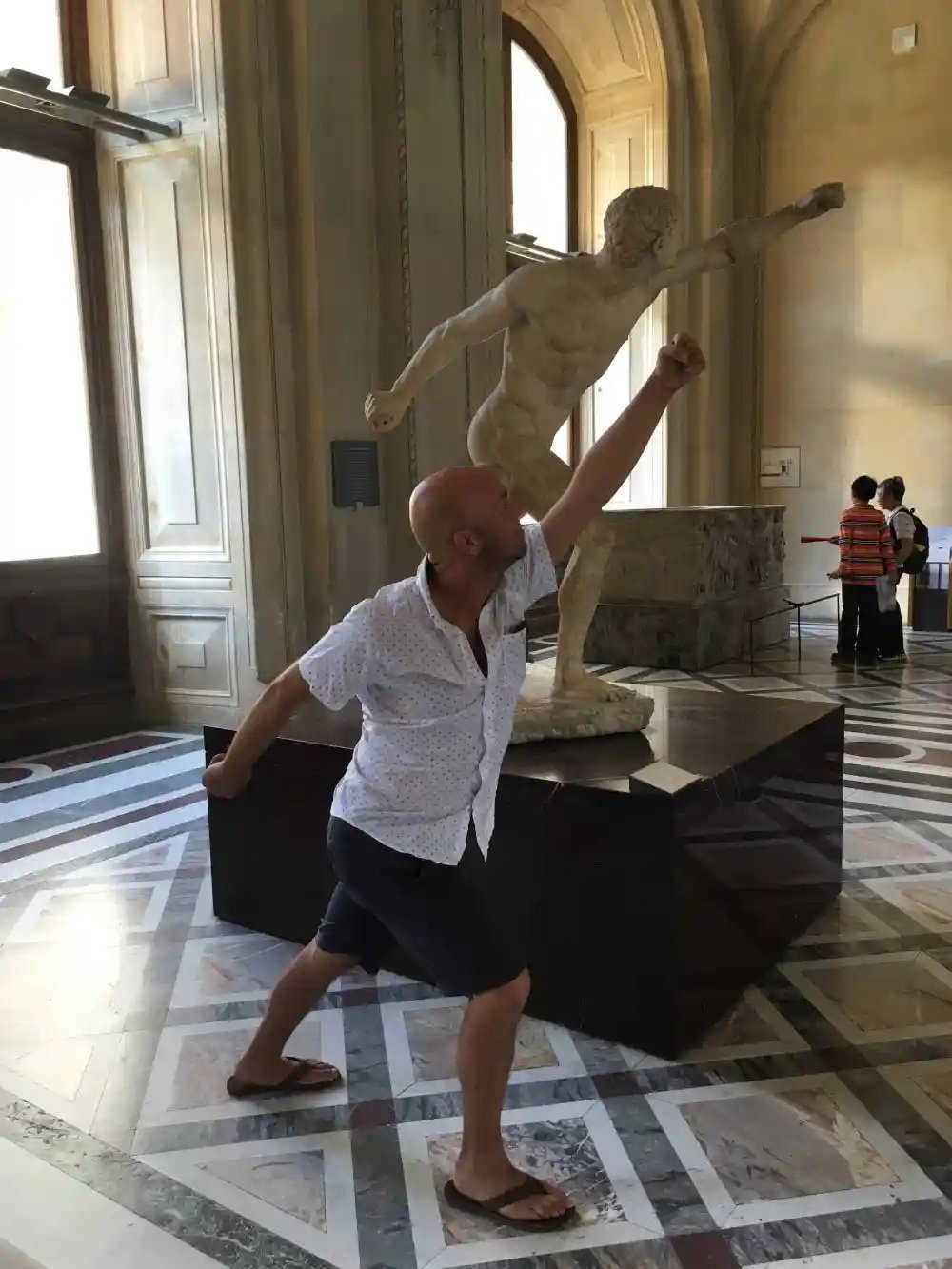To Get People Aligned, Find the Echo in Your Leadership Story
Last July, when I was in Paris, I visited the Louvre Museum. Bad decision. The summertime crowds were overwhelming, with their matching outfits and their selfie sticks. I struggled to see Mona Lisa smile through a maze of ball caps. Winged Nike looked positively turtle-like among the hordes. I nearly broke my arms off trying to get up close to Venus de Milo.
After a few hours, I was exhausted, and craving a croissant and café au lait. As I made my way towards the museum's exit, I passed through an area full of marble sculptures from ancient Greece and saw something that stopped me in my tracks. It was a statue called Borghese Gladiator. A nude, muscular youth was depicted in a defensive position, fearful expression on his face, one arm extended forward as if blocking a blow, the other arm backwards as if holding a sword, preparing a counter attack. In front of the statue, three Chinese teenagers were emulating his body position, posing for a photograph. The teenagers weren't much older than the Gladiator. I stopped to watch them.
For the next hour, one person after the next stopped in front of the Gladiator to emulate his pose. Old people, young people, boys, girls, Asians, Europeans, North Americans and Africans. It was beautiful. Standing there, watching silently, I reflected on how one sculptor's two thousand year old artistic insight still had the power to stop people in their tracks. Whatever it was that original sculptor had experienced, it was still echoing through the ages, reverberating within the chests of these modern tourists with their selfie sticks.
The thought was so beautiful that it made me cry. I couldn't resist posing like the Gladiator myself.
Great Leadership Stories Echo Inside of Us
Whenever I teach leadership storytelling workshops, I often re-tell this story. I do so in order to confront one of the biggest misconceptions that business people have about storytelling. For most professionals, storytelling is all about a pitch, or a value proposition, or a mission statement -- some carefully architected series of words that is meant to "tell the story" in a clear and logical way. Help me nail the story, these leaders think, and I'll never need to think about this again.
But what the Borghese Gladiator teaches us is that stories are embodied experiences. Great stories feel right. They ring true. They resonate in such a way that is recognizable, even if we don't have the language to explain why.
This is the poetics behind great storytelling. Something in the story echoes with us, and triggers some ancient memory lodged deep in our DNA.
Lots of storytelling trainers like to teach the structure of storytelling: plots, conflicts and characters, the Hero's Journey and so on. Learning these concepts will make you a better storyteller. But they won't make you great. Great leadership stories are built on these strange poetic experiences. These echoes. If you find something that echoes, then the structure and delivery becomes less important. The clarity of that echo pierces through, even if the structure is sloppy.
For example, watch Steve Jobs' most famous speech: his 2005 commencement address at Stanford, where he delivered the famous "Stay Hungry, Stay Foolish" line. As far as storytelling goes, it's not great. Jobs doesn't wrap the audience around his pinkie finger, in the way that Obama could do in his finest moments. The structure of the speech is simple, deliberate, straightforward.
But there is something piercing about the speech. Especially when Jobs delivers his recommendations for life, around 12:30 in, you can tell that he isn't simply reciting the kinds of things that life coaches post on Instagram.
Clearly, this is what he believes -- this is his truth. And because it's true for him, it echoes inside of us, and into eternity.
We Create Alignment With the Echo in our Stories
We live in the age of the tweet, the spontaneous thought, a first draft world where very few people take the time to think through the deeper meaning behind their message. Opinions are barraging us from every angle. Fewer and fewer of us feel aligned to the traditional identities that have created structure in the lives of our parents and grandparents.
For leaders who are trying to create a sense of belonging in their culture or unify a team towards some common goal, the secret to great leadership storytelling comes not from the strategy, but from the echo. When people resonate with that echo, they're much more likely to act cohesively.
The echo will change from audience to audience. The climate change narrative has an echo, among a certain demographic. Among another demographic, so does Trump. The best startups have echoes. So does the narrative around feminism and #metoo. Ultimately, it’s these emotional echoes that drives the narratives forward. These echoes -- felt in our bodies -- compel us to share and act.
How do you find your echo? There is no How To list, no basic structure, no five easy steps to follow. Start with an insight that feels deeply true to you. Drop down one level deeper. See how far the rabbit hole goes.
The best stories aren’t built out of a paint-by-numbers style structure.
They’re real.
What makes them real is what makes them echo.



